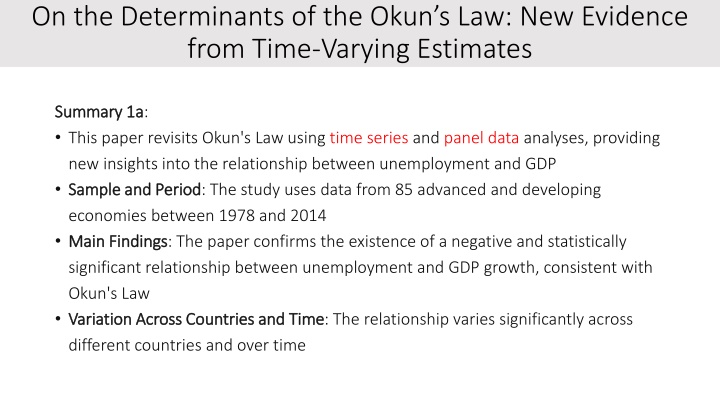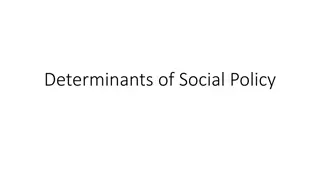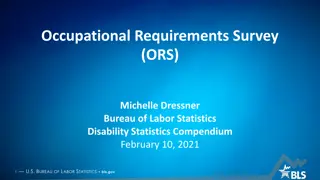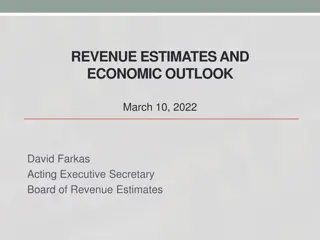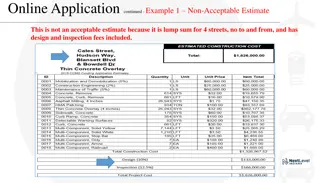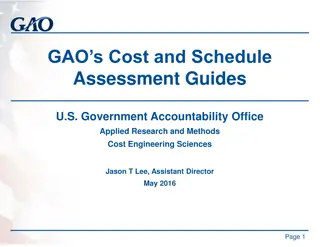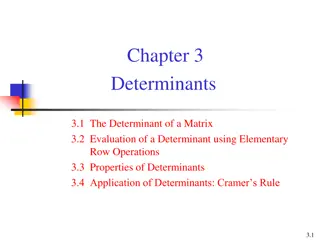Determinants of Okun's Law: New Insights from Time-Varying Estimates
This paper revisits Okun's Law using time series and panel data analyses, confirming a negative relationship between unemployment and GDP growth across 85 economies from 1978 to 2014. Factors influencing Okun's coefficient include labor market institutions, economic structure, fiscal policy, demographic changes, and quality of jobs created.
Download Presentation

Please find below an Image/Link to download the presentation.
The content on the website is provided AS IS for your information and personal use only. It may not be sold, licensed, or shared on other websites without obtaining consent from the author.If you encounter any issues during the download, it is possible that the publisher has removed the file from their server.
You are allowed to download the files provided on this website for personal or commercial use, subject to the condition that they are used lawfully. All files are the property of their respective owners.
The content on the website is provided AS IS for your information and personal use only. It may not be sold, licensed, or shared on other websites without obtaining consent from the author.
E N D
Presentation Transcript
On the Determinants of the Okuns Law: New Evidence from Time-Varying Estimates Summary 1 Summary 1a a: This paper revisits Okun's Law using time series and panel data analyses, providing new insights into the relationship between unemployment and GDP Sample and Period Sample and Period: The study uses data from 85 advanced and developing economies between 1978 and 2014 Main Findings Main Findings: The paper confirms the existence of a negative and statistically significant relationship between unemployment and GDP growth, consistent with Okun's Law Variation Across Countries and Time Variation Across Countries and Time: The relationship varies significantly across different countries and over time
On the Determinants of the Okuns Law: New Evidence from Time-Varying Estimates Summary 1 Summary 1b b: The paper identifies several factors that affect the variation in Okun's coefficient: Labor Market Institutions Labor Market Institutions: Differences in labor market policies, such as employment protection legislation and union density, can influence how changes in GDP affect unemployment. Economic Structure Economic Structure: The composition of the economy (e.g., the share of services vs. manufacturing) can impact the relationship between GDP and unemployment. Fiscal Policy Fiscal Policy: Government spending and taxation policies can affect economic activity and, consequently, the unemployment rate. Demographic Changes Demographic Changes: Variations in the age distribution and labor force participation rates can alter the dynamics between GDP and unemployment. Quality of Jobs Created Quality of Jobs Created: The nature of jobs generated during economic expansions, whether they are high-skilled or low-skilled, can influence the unemployment rate.
On the Determinants of the Okuns Law: New Evidence from Time-Varying Estimates key insights: key insights: Okun s Law Validity Okun s Law Validity: The study confirms a negative and statistically significant relationship between unemployment and output, known as Okun s Law, across 85 advanced and developing economies from 1978 to 2014. Variation Across Countries Variation Across Countries: The strength of Okun s Law varies significantly across countries, being stronger in those with higher average unemployment, larger public employment, lower informality, and smaller agricultural sectors. Influence of Market Regulations Influence of Market Regulations: Deregulation in labor and product markets, as well as economic recessions, have strengthened the response of unemployment to the business cycle within countries Methodology Methodology: The study uses time-varying coefficient models to assess changes in Okun s Law over time and across different countries, providing a more dynamic understanding of the relationship.
On the Determinants of the Okuns Law: New Evidence from Time-Varying Estimates P Policy implications: olicy implications: Labor Market Deregulation Labor Market Deregulation: Deregulation in labor and product markets can strengthen the response of unemployment to the business cycle, suggesting that more flexible labor markets may help in reducing unemployment during economic downturns Public Employment Public Employment: A larger share of public employment is associated with a stronger Okun s relationship, indicating that public sector jobs can act as a buffer during economic fluctuations. Economic Diversification Economic Diversification: Countries with more diversified economies tend to have a stronger Okun s relationship, implying that diversification can enhance economic stability. Recession Response Recession Response: The findings highlight the importance of targeted policies during recessions to mitigate the impact on unemployment, as the Okun s coefficient tends to increase during and after negative growth periods.
Does One Law Fit All? Cross-Country Evidence on Okuns Law Okun s Law Okun s Law describes the inverse relationship between cyclical fluctuations in output in output and the unemployment rate. unemployment rate. When an economy s output deviates from its potential, firms adjust their workforce accordingly, leading to (cyclical) changes in the unemployment rate. Here are the key points: Inverse Relationship Inverse Relationship: As output increases, unemployment tends to decrease, and vice versa. Okun Coefficient Okun Coefficient: This measures the responsiveness of unemployment to changes in output Policy Implications Policy Implications: Understanding this relationship helps in designing effective macroeconomic stabilization policies. cyclical fluctuations
Does One Law Fit All? Cross-Country Evidence on Okuns Law Summary 1 Summary 1: Okun s Law Comparison: Okun s Law Comparison: The paper compares the performance of Okun s Law in advanced and developing economies, finding that the Okun coefficient is about half as large in developing countries. The paper analyzes data from 71 countries 71 countries, classified into 29 advanced advanced and 42 developing countries. 42 developing countries. The time period covered is 1980 to 2015 2015, although data for many developing countries starts later. The sample includes countries with at least 20 years of annual data 20 years of annual data and a population exceeding 3 million 3 million Heterogeneity Heterogeneity: There is significant heterogeneity across countries, with some developing countries fitting Okun s Law well. Variability Across Countries: Countries: The Okun coefficient, which measures the responsiveness of labor markets to output fluctuations, varies significantly between advanced and developing countries, and even within these groups 29 1980 to Variability Across
Does One Law Fit All? Cross-Country Evidence on Okuns Law Summary 1 Summary 1: BLL (2017) show that Okun s Law has held up well for a set of 20 advanced economies. The responsiveness of unemployment or employment to output the so-called Okun coefficient does vary across countries, however, and for reasons that are not easy to explain Poor Fit in Developing Countries: Okun s Law fits less well in developing countries, with lower average R-square values indicating weaker correlations between output and unemployment (see tables 1,2,3,4 ) (see tables 1,2,3,4 ) Key Associations Key Associations: The mean unemployment rate and the share of services in GDP are associated with the Okun coefficient, while other factors like labor and product market flexibility do not consistently play a role. Policy Implications Policy Implications: Understanding the determinants of labor market outcomes in developing countries is crucial for effective macroeconomic stabilization policies.
Does One Law Fit All? Cross-Country Evidence on Okuns Law S Summary 2a: ummary 2a: Shadow Economy Shadow Economy: The presence of a shadow or informal economy can obscure the relationship between the formal labor market and measured output, affecting the Okun coefficient Service Sector Service Sector: Countries with a higher share of services in GDP tend to have more responsive employment changes to output fluctuations. Skill Mismatch Skill Mismatch: Skill mismatches can influence how unemployment responds to economic shocks, with higher mismatches leading to weaker responses Labor and Business Regulations Labor and Business Regulations: The responsiveness of labor markets may depend on regulations, but the document finds little association between the Okun coefficient and aggregate measures of labor or product market flexibility
Does One Law Fit All? Cross-Country Evidence on Okuns Law Summary 2b: (more on Skill Mismatch) Skill Mismatch Skill Mismatch: The paper discusses how skill mismatches can influence unemployment rates, particularly in developing countries: Weaker Response to Output: Higher skill mismatches are associated with a weaker response of unemployment to economic output changes (see fig 12) Labor Market Dynamics: Skill mismatches can lead to inefficiencies in the labor market, making it harder for employers to find suitable candidates and for workers to find appropriate jobs. Policy Implications: Addressing skill mismatches through education and training programs can improve labor market outcomes and reduce unemployment.
